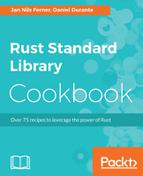BiLocks are used when we need to store a value across multiple threads with up to two owners associated with that value. Applicable uses for a BiLock type would be splitting TCP/UDP data for reading and writing, or adding a layer between a sink and a stream (for logging, monitoring, and so on), or it can be a sink and a stream at the same time.
When using futures with an additional crate (such as tokio or hyper), knowing BiLocks can help us wrap data around the other crate's common methods. This would allow us to build futures and concurrency on top of existing crates without having to wait until the crate's maintainers support concurrency explicitly. BiLocks are a very low-level utility, but understanding how they work can help us further down the road with our (web) applications.
In the next chapter, we will mostly focus on networking with Rust, but we will also get to practice integrating futures with other crates. BiLocks can be used throughout these next examples, if you wanted to split a TCP/UDP stream in a mutex state, although it is not necessary to do so with the crates that we will be using.
